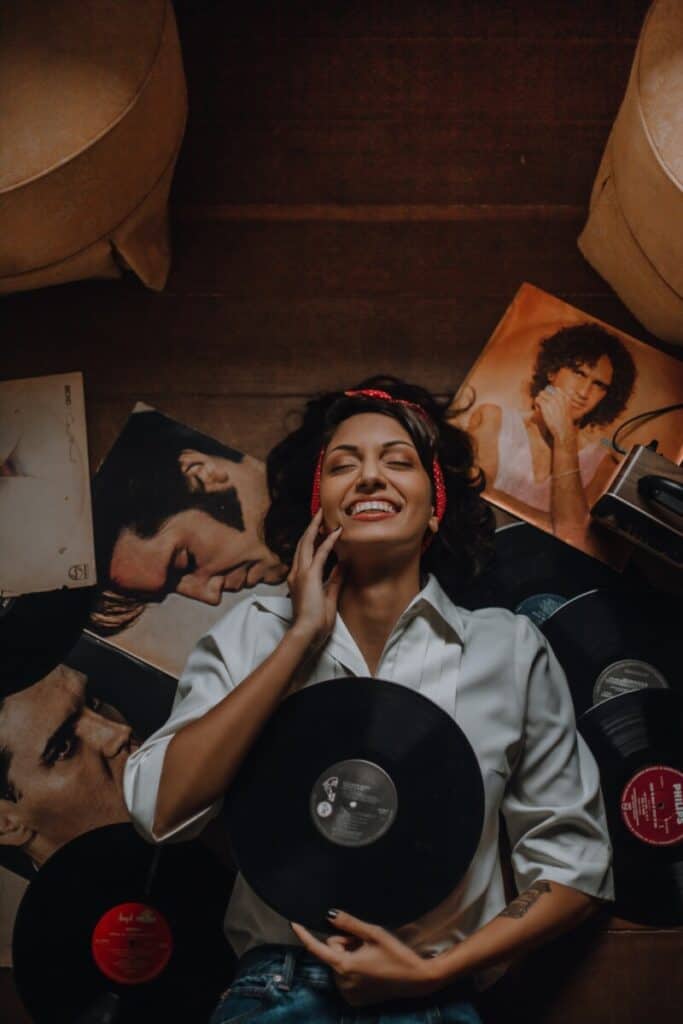With today’s technology, changing how music sounds is pretty straightforward. This includes taking even the newest songs and making them sound like the classics. But how do you do this exactly? What software do you need?
The key to making music sound old or like the hits of decades prior is understanding why older music sounds the way it does. For example, in the 80s, they had a famous synthesizer known as the Yamaha DX7 that produced sounds heard across many songs in that era.
We will be going over the various ways that you can make music sound older. If you would like to learn more, we encourage you to read further on!

What Makes Music Sound Old?
The further back you go into music history, the more different it becomes. You have the early 90s, 80s, 70s, 60s, 50s, etc., each one is unique in its own way. There are two factors to this: the type of music popular in those eras and the technology available to them.
We will use the 80s as an example since music from that era is still popular to this day, and we can pinpoint why music from that era sounds the way it does. For example, the sounds you typically hear in 80s music are very specific to that era, and there is a good reason for why that is.
Synthesizers were not widespread until the 80s due to their cost. However, this changed with the introduction of the Yamaha DX7, a synthesizer that was more affordable while still being able to help produce a wide array of music.
The sounds you hear in 80s music are likely to have come from this specific synthesizer. We will post a video below that demonstrates it so you can hear what we are talking about.
Sounds pretty 80s, right? This cool piece of technology is what drove many of your favorite 80s hits, and with modern technology, people all over the world are able to produce 80s – like music.
You will also hear plenty of snare drums and gated reverb in 80s music. Making drums sound as big as possible was a popular thing to do, while these days, you tend to hear mostly more “natural” sounding drums.
So, in short, specific sounds in music tend to be able to date it. Music from the 50s is significantly different from the 80s, and the 2000s music sounds different from the 80s.

Choose the Music Era You Want to Replicate
First, you will have to decide which era of music you would like to replicate. We went over some of the basics that can help you create music that sounds like it came out of the 80s, but you will also need to have an understanding of other eras as well to be able to replicate that era. These will be general tips and not specific to a decade.
Pick Your Genre
The next thing to do is pick your genre of music, which can vary from the music we have today in that same genre. For example, early rock music is not going to sound like modern rock. Similarly, the early 90s rap music also has a distinct vibe vs. modern rap.
Next, it is important to understand in what ways the genre differed back then from today. Did they use specific beats, sounds, or did not have something we have today? Work with the unique qualities of the music to create something of your own. It is a fun experience recreating an older style of music that is not made anymore or is only made by a small number of people!

Choose Your Instruments and Rhythm
Understanding the instruments and sounds commonly used is important in replicating older music.
For example, in the 1950s, the saxophone and piano were popular before drums, guitars, and bass were brought in. If you want the average person to understand what era you are trying to go for, using the popular instruments of that era will go a long way.
Next, you will need to understand what the popular rhythms were back then. In almost any era of music, there will be rhythms born out of using what was available and what became popular. You will quickly catch on to what was widely used by listening through a “greatest hits” collection from that era.
Choose the Type of Sound You Want to Go For
You may have noticed that certain eras of music have their own distinct sound qualities. You will instantly be able to discern music from the ’50s and earlier, not just from the instruments used or the style of singing, but also the audio quality, the slight crackles, and instruments being muffled.
Speaking of audio quality, before CDs became widespread or even used. Tape was how you listened to tunes, which limited the overall fidelity of the music. And before that, you would use a record player.
These days, you can put modern music through various filters to make it sound different. You have filters that can make music sound like it is an arena, but you can also grab ones that mimic music being played from a tape or a vinyl record.
You can also manually add in vinyl crackles and tape hisses to control when they pop up in a song. You can use this in creative ways, such as if you want to emphasize a certain part of a song or have the noise be part of the rhythm. The beauty of producing music digitally is that you pretty much have full control over how you want your music to sound.
Making Your Music Sound Analog
For some people, making music sound old simply means including analog touches that are lost when producing music digitally. We went over adding in vinyl crackles and tape hisses in music that is intentionally trying to sound like it came from a specific era, but it can also benefit modern music.
Lo-fi hip-hop, for example, has become quite popular for people who are trying to get work done, and if you are someone who listens to it for hours on end, you may have noticed that many tracks include vinyl crackles at specific points such as transitioning to a different beat.
Another way to add “life” to your music is to blend in with ambient noise. You can grab sounds yourself by heading to the outside world to record everyday sounds and appropriately add them to your music. Sound effects and ambient noise are used all the time to really complete a song.
If you would like to learn the ins and outs of music production to really make your music stand out, this Tommy Swindali’s Music Production Guide has been a convenient tool for many aspiring music producers!
- Swindali, Tommy (Author)
- English (Publication Language)
- 133 Pages - 01/23/2020 (Publication Date) - Independently published (Publisher)
Last update on 2025-06-30 / Affiliate links / Images from Amazon Product Advertising API
For more information, check out this article about the best tape machines for home studio.
Conclusion
Making music that sounds old requires an understanding of what you are trying to go for. Different eras of music will have their own unique qualities. We went over what makes 80s music sound so different from pretty much any other era of music and gave examples of the types of sounds you can use to create an 80s-esque song in modern times.
This is only a small guide to suggest what you should consider when approaching making retro music. The ins and outs of music production itself is a very large and detailed topic. We wish you the best!
If you want to learn to record a song with background music, click here!
Sources
- MusicRadar: 12 Sure-Fire ways to achieve a vintage sound
- How-To Geek: How to Add the Nostalgic Hiss and Pop of a Vinyl Record to MP3 Files
- MasteringBox: Getting That 80s Sound Right: 6 Tips to Produce 80s Music
Recent Posts
QuickTime is a vital app for many Mac users, and if you’ve recently bought a new microphone, you might wonder how to use it optimally. QuickTime cannot record audio content if it doesn’t have...
Every microphone leaves a unique signature on the quality of its output. If you’re a podcaster trying to melt your way into your audience’s hearts, a muddy, distorted recording won’t cut it....

